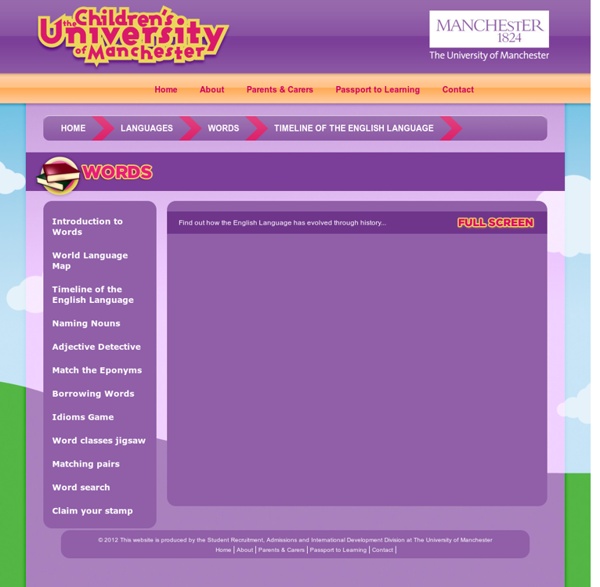



Geologic time scale Online exhibits Geologic time scale Take a journey back through the history of the Earth — jump to a specific time period using the time scale below and examine ancient life, climates, and geography. Ways to begin your exploration: Use the links in the "time machine" below and explore a specific period that interests you.Read more about the geologic time scale, its origins and its time divisions.Find out more about plate tectonics, an important geological concept in any time period! Food Timeline: food history research service Do you speak Uglish? How English has evolved in Uganda Please don’t dirten my shirt with your muddy hands. Stop cowardising and go and see that girl. Don’t just beep her again, bench her. Typos? No, we’re speaking Uglish (pronounced you-glish), a Ugandan form of English influenced by Luganda and other local dialects, which has produced hundreds of words with their own unique meanings. Some will be immediately obvious to English speakers: dirten, meaning to make dirty; cowardising, to behave like a coward. Others offer small insights into youth culture: beep – meaning to ring someone but to hang up quickly before the person answers. Now, Bernard Sabiti, a Ugandan cultural commentator has recorded these colloquialisms in a new book which attempts to unlock what he calls “one of the funniest and strangest English varieties in the world”. Working as a consultant for international NGOs, Sabiti kept being asked “what kind of English do Ugandans speak?” The result? He also credits local musicians for introducing a number of words into the lexicon.
Brief Timeline of American Literature and Events, 1620-1920 Brief Timeline of American Literature and Events: Pre-1620 to 1920 This timeline provides a short chronology of events in American history and literature. It is linked to course pages and bibliographies as well as to a set of more general linked resources: pages on American authors, literary movements, and American literature sites. Each author page contains a picture (if available), a bibliography (if available), links to major sites about the author, and links to works online.
English Timeline This interactive timeline allows you to explore the evolution of English language and literature, from the 11th century to the present day. Scroll through decade by decade to investigate the richness and diversity of our poetry and prose, as well as the many social, cultural and political strands from which our language has been woven. The timeline includes a fascinating combination of texts: Anglo Saxon tales and medieval illuminations; iconic literary manuscripts and printed texts; as well as letters, newspapers, handbills, posters, charters, speeches and campaign leaflets. Launch the interactive Flash timeline above, or explore the collections within each of the centuries below. Beowulf, Anglo Saxon monsters & more... The beginnings of Middle English & more...
25 maps that explain the English language English is the language of Shakespeare and the language of Chaucer. It’s spoken in dozens of countries around the world, from the United States to a tiny island named Tristan da Cunha. It reflects the influences of centuries of international exchange, including conquest and colonization, from the Vikings through the 21st century. Here are 25 maps and charts that explain how English got started and evolved into the differently accented languages spoken today. The origins of English 1) Where English comes from English, like more than 400 other languages, is part of the Indo-European language family, sharing common roots not just with German and French but with Russian, Hindi, Punjabi, and Persian. 2) Where Indo-European languages are spoken in Europe today Saying that English is Indo-European, though, doesn’t really narrow it down much. 3) The Anglo-Saxon migration 4) The Danelaw The next source of English was Old Norse. 5)The Norman Conquest 6) The Great Vowel Shift The spread of English Credits
Geologic Time Scale - Geological Time Line - Geology.com Dividing Earth History into Time Intervals Geologists have divided Earth's history into a series of time intervals. These time intervals are not equal in length like the hours in a day. Instead the time intervals are variable in length. This is because geologic time is divided using significant events in the history of the Earth. Examples of Boundary "Events" For example, the boundary between the Permian and Triassic is marked by a global extinction in which a large percentage of Earth's plant and animal species were eliminated. Eons are the largest intervals of geologic time and are hundreds of millions of years in duration. Eras Eons are divided into smaller time intervals known as eras. Periods Eras are subdivided into periods. Epochs Finer subdivisions of time are possible and the periods of the Cenozoic are frequently subdivided into epochs. Our geologic time scale was constructed to visually show the duration of each time unit. Contributor: Hobart King More Geologic Time Scale Resources
Beautiful web-based timeline software